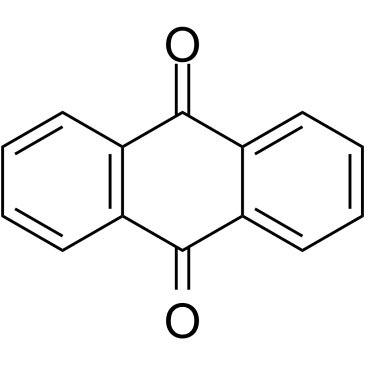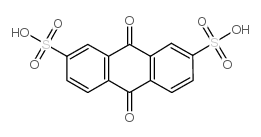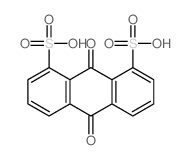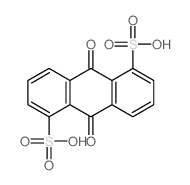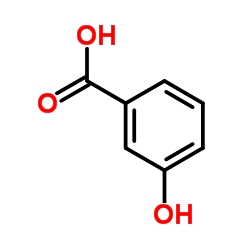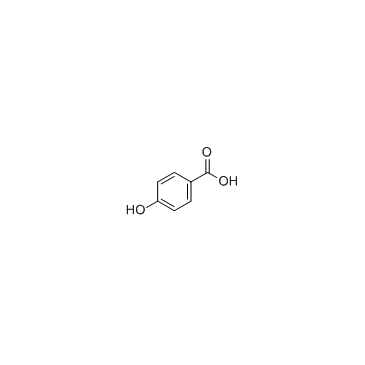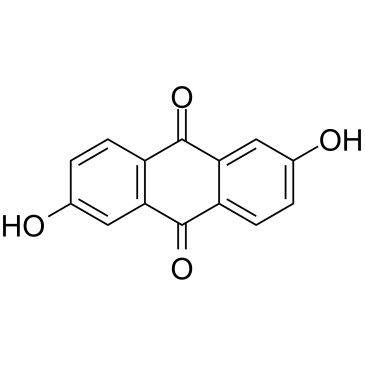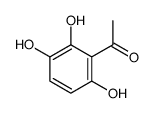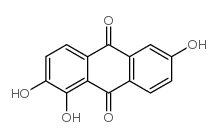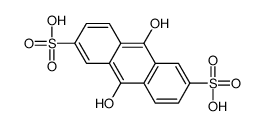84-50-4
| 中文名 | 蒽醌-2,6-二磺酸钠 |
|---|---|
| 英文名 | anthraquinone-2,6-disulfonic acid |
| 中文别名 |
9,10-二氢化-9,10-二氧代-2,6-蒽二磺酸
蒽醌二磺酸二钠 蒽醌-2,6-二磺酸二钠 |
| 英文别名 |
9,10-Dioxo-9,10-dihydro-anthracen-2,6-disulfonsaeure
2,6-Disulfoanthraquinone anthraquinone-2,6-sulfonic acid 2,6-anthraquinonedisulphonic acid 9,10-dioxoanthracene-2,6-disulfonic acid 9,10-Anthraquinone-2,6-disulfonic acid 2,6-disulfo-9,10-anthraquinone ANTHRAQUINONE-2,6-DISULFONIC ACID UNII-WN018KNQ7W 9,10-Anthraquinone-2,6-disulfonate 9,10-dioxo-9,10-dihydro-anthracene-2,6-disulfonic acid MFCD00001230 EINECS 201-534-9 |
| 熔点 | 325ºC |
|---|---|
| 分子式 | C14H8O8S2 |
| 分子量 | 368.33900 |
| 精确质量 | 367.96600 |
| PSA | 159.64000 |
| LogP | 3.11700 |
| 外观性状 | solid |
| 储存条件 | 应密封于阴凉干燥处保存。 |
| 计算化学 | 1.疏水参数计算参考值(XlogP):0.4 2.氢键供体数量:2 3.氢键受体数量:8 4.可旋转化学键数量:2 5.互变异构体数量:无 6.拓扑分子极性表面积160 7.重原子数量:24 8.表面电荷:0 9.复杂度:692 10.同位素原子数量:0 11.确定原子立构中心数量:0 12.不确定原子立构中心数量:0 13.确定化学键立构中心数量:0 14.不确定化学键立构中心数量:0 15.共价键单元数量:1 |
| 更多 | 1. 性状:黄色针状结晶或粉末 2. 密度(g/mL,25℃):未确定 3. 相对蒸汽密度(g/mL,空气=1):未确定 4. 熔点(ºC):325 5. 沸点(ºC,常压):未确定 6. 沸点(ºC,50mmHg):未确定 7. 折射率(n20/D):未确定 8. 闪点(ºC):未确定 9. 比旋光度(º):未确定 10. 自燃点或引燃温度(ºC):未确定 11. 蒸气压(mmHg,40ºC):未确定 12. 饱和蒸气压(kPa,125ºC):未确定 13. 燃烧热(KJ/mol):未确定 14. 临界温度(ºC):未确定 15. 临界压力(KPa):未确定 16. 油水(辛醇/水)分配系数的对数值:未确定 17. 爆炸上限(%,V/V):未确定 18. 爆炸下限(%,V/V):未确定 19. 溶解性:与水溶解 |
Synonym: Section 2 - COMPOSITION, INFORMATION ON INGREDIENTS
Risk Phrases: None Listed. Section 3 - HAZARDS IDENTIFICATION EMERGENCY OVERVIEW
The toxicological properties of this material have not been fully investigated. Potential Health Effects Eye: Dust may cause mechanical irritation. Skin: May cause skin irritation. Ingestion: May cause irritation of the digestive tract. The toxicological properties of this substance have not been fully investigated. Inhalation: May cause respiratory tract irritation. The toxicological properties of this substance have not been fully investigated. Chronic: No information found. Section 4 - FIRST AID MEASURES Eyes: Flush eyes with plenty of water for at least 15 minutes, occasionally lifting the upper and lower eyelids. Get medical aid immediately. Skin: Get medical aid. Flush skin with plenty of water for at least 15 minutes while removing contaminated clothing and shoes. Wash clothing before reuse. Ingestion: If victim is conscious and alert, give 2-4 cupfuls of milk or water. Never give anything by mouth to an unconscious person. Get medical aid immediately. Inhalation: Remove from exposure and move to fresh air immediately. If not breathing, give artificial respiration. If breathing is difficult, give oxygen. Get medical aid. Notes to Physician: Antidote: None reported. Section 5 - FIRE FIGHTING MEASURES General Information: As in any fire, wear a self-contained breathing apparatus in pressure-demand, MSHA/NIOSH (approved or equivalent), and full protective gear. During a fire, irritating and highly toxic gases may be generated by thermal decomposition or combustion. Extinguishing Media: Use water spray, dry chemical, carbon dioxide, or appropriate foam. Section 6 - ACCIDENTAL RELEASE MEASURES General Information: Use proper personal protective equipment as indicated in Section 8. Spills/Leaks: Clean up spills immediately, observing precautions in the Protective Equipment section. Sweep up or absorb material, then place into a suitable clean, dry, closed container for disposal. Avoid generating dusty conditions. Provide ventilation. Section 7 - HANDLING and STORAGE Handling: Wash thoroughly after handling. Remove contaminated clothing and wash before reuse. Use with adequate ventilation. Minimize dust generation and accumulation. Avoid contact with eyes, skin, and clothing. Keep container tightly closed. Avoid ingestion and inhalation. Storage: Keep container closed when not in use. Store in a tightly closed container. Store in a cool, dry, well-ventilated area away from incompatible substances. Section 8 - EXPOSURE CONTROLS, PERSONAL PROTECTION Engineering Controls: Use adequate ventilation to keep airborne concentrations low. Exposure Limits CAS# 84-50-4: Personal Protective Equipment Eyes: Wear appropriate protective eyeglasses or chemical safety goggles as described by OSHA's eye and face protection regulations in 29 CFR 1910.133 or European Standard EN166. Skin: Wear appropriate protective gloves to prevent skin exposure. Clothing: Wear appropriate protective clothing to prevent skin exposure. Respirators: Follow the OSHA respirator regulations found in 29 CFR 1910.134 or European Standard EN 149. Use a NIOSH/MSHA or European Standard EN 149 approved respirator if exposure limits are exceeded or if irritation or other symptoms are experienced. Section 9 - PHYSICAL AND CHEMICAL PROPERTIES Physical State: Powder Color: pink Odor: None reported. pH: Not available. Vapor Pressure: Not available. Viscosity: Not available. Boiling Point: Not available. Freezing/Melting Point: 325 deg C Autoignition Temperature: Not applicable. Flash Point: Not applicable. Explosion Limits, lower: N/A Explosion Limits, upper: N/A Decomposition Temperature: Solubility in water: Specific Gravity/Density: Molecular Formula: C14H6O8S2Na2 Molecular Weight: 412.29 Section 10 - STABILITY AND REACTIVITY Chemical Stability: Stable under normal temperatures and pressures. Conditions to Avoid: Incompatible materials, dust generation, strong oxidants. Incompatibilities with Other Materials: Oxidizing agents. Hazardous Decomposition Products: Carbon monoxide, oxides of sulfur, irritating and toxic fumes and gases, carbon dioxide. Hazardous Polymerization: Has not been reported. Section 11 - TOXICOLOGICAL INFORMATION RTECS#: CAS# 84-50-4 unlisted. LD50/LC50: Not available. Carcinogenicity: Anthraquinone-2,6-disulfonic acid, disodium salt - Not listed by ACGIH, IARC, or NTP. Section 12 - ECOLOGICAL INFORMATION Section 13 - DISPOSAL CONSIDERATIONS Dispose of in a manner consistent with federal, state, and local regulations. Section 14 - TRANSPORT INFORMATION IATA Not regulated as a hazardous material. IMO Not regulated as a hazardous material. RID/ADR Not regulated as a hazardous material. Section 15 - REGULATORY INFORMATION European/International Regulations European Labeling in Accordance with EC Directives Hazard Symbols: Not available. Risk Phrases: Safety Phrases: S 24/25 Avoid contact with skin and eyes. S 28A After contact with skin, wash immediately with plenty of water. S 37 Wear suitable gloves. S 45 In case of accident or if you feel unwell, seek medical advice immediately (show the label where possible). WGK (Water Danger/Protection) CAS# 84-50-4: No information available. Canada CAS# 84-50-4 is listed on Canada's NDSL List. CAS# 84-50-4 is not listed on Canada's Ingredient Disclosure List. US FEDERAL TSCA CAS# 84-50-4 is listed on the TSCA inventory. SECTION 16 - ADDITIONAL INFORMATION N/A |
| 安全声明 (欧洲) | S24/25 |
|---|---|
| 海关编码 | 2914399090 |
|
~% 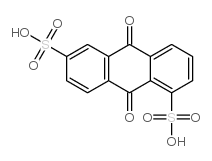
84-50-4 |
| 文献:DE214156 ; Fortschr. Teerfarbenfabr. Verw. Industriezweige, vol. 9, p. 670 |
|
~% 
84-50-4 |
| 文献:Annali di Chimica Applicata, , vol. 22, p. 272,273,275 US2074307 , ; |
|
~% 
84-50-4 |
| 文献:Annali di Chimica Applicata, , vol. 22, p. 272,273,275 US2074307 , ; |
|
~% 
84-50-4 |
| 文献:Helvetica Chimica Acta, , vol. 10, p. 199 Journal fuer Praktische Chemie (Leipzig), , vol. <2>131, p. 374 |
|
~% 
84-50-4 |
| 文献:Helvetica Chimica Acta, , vol. 10, p. 199 Journal fuer Praktische Chemie (Leipzig), , vol. <2>131, p. 374 |
|
~% 
84-50-4 |
| 文献:Helvetica Chimica Acta, , vol. 10, p. 199 Journal fuer Praktische Chemie (Leipzig), , vol. <2>131, p. 374 |
|
~% 
84-50-4 |
| 文献:Annali di Chimica Applicata, , vol. 22, p. 272,273,275 US1790448 , ; |
|
~% 
84-50-4
详细
|
| 文献:Chemische Berichte, , vol. 9, p. 681 Chemische Berichte, , vol. 3, p. 359 ; Fortschr. Teerfarbenfabr. Verw. Industriezweige, vol. 1, p. 302 Justus Liebigs Annalen der Chemie, , vol. 160, p. 126 |
| 上游产品 7 | |
|---|---|
| 下游产品 9 | |
| 海关编码 | 2914399090 |
|---|---|
| 中文概述 | 2914399090. 其他不含其他含氧基的芳香酮. 增值税率:17.0%. 退税率:13.0%. 监管条件:无. 最惠国关税:5.5%. 普通关税:30.0% |
| 申报要素 | 品名, 成分含量, 用途, 丙酮报明包装 |
| Summary | 2914399090. other aromatic ketones without other oxygen function. VAT:17.0%. Tax rebate rate:13.0%. . MFN tariff:5.5%. General tariff:30.0% |

